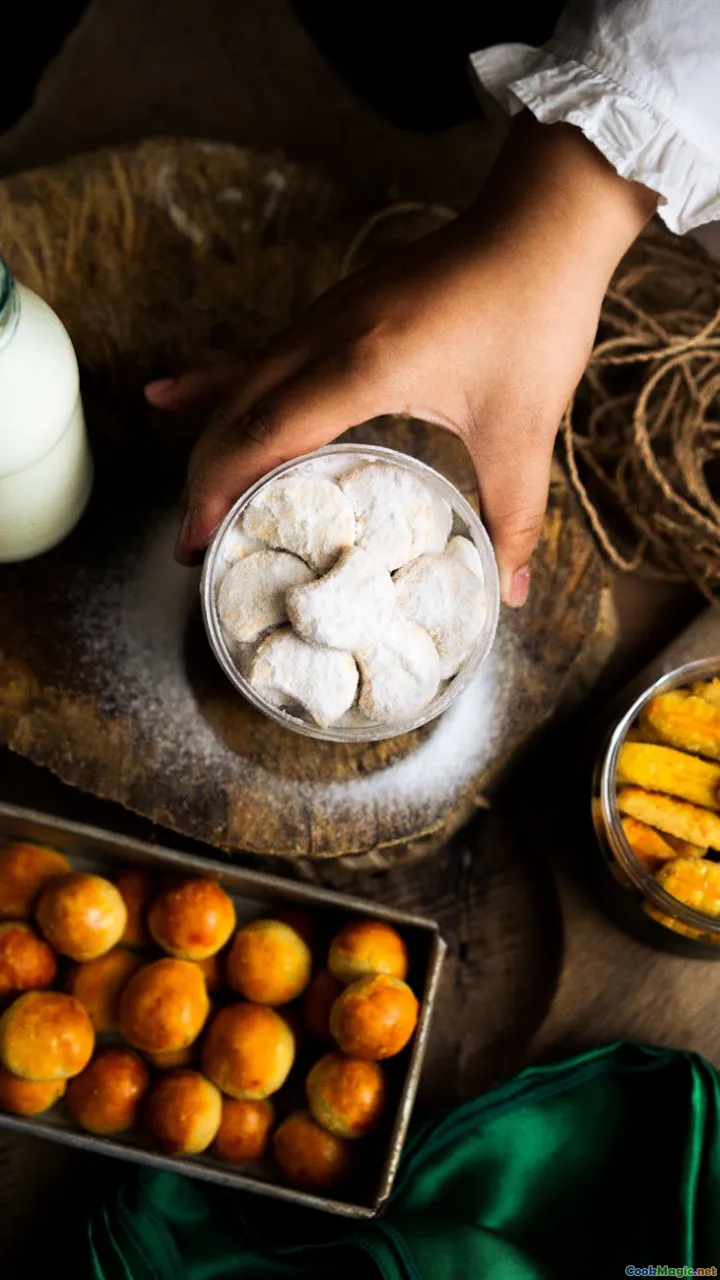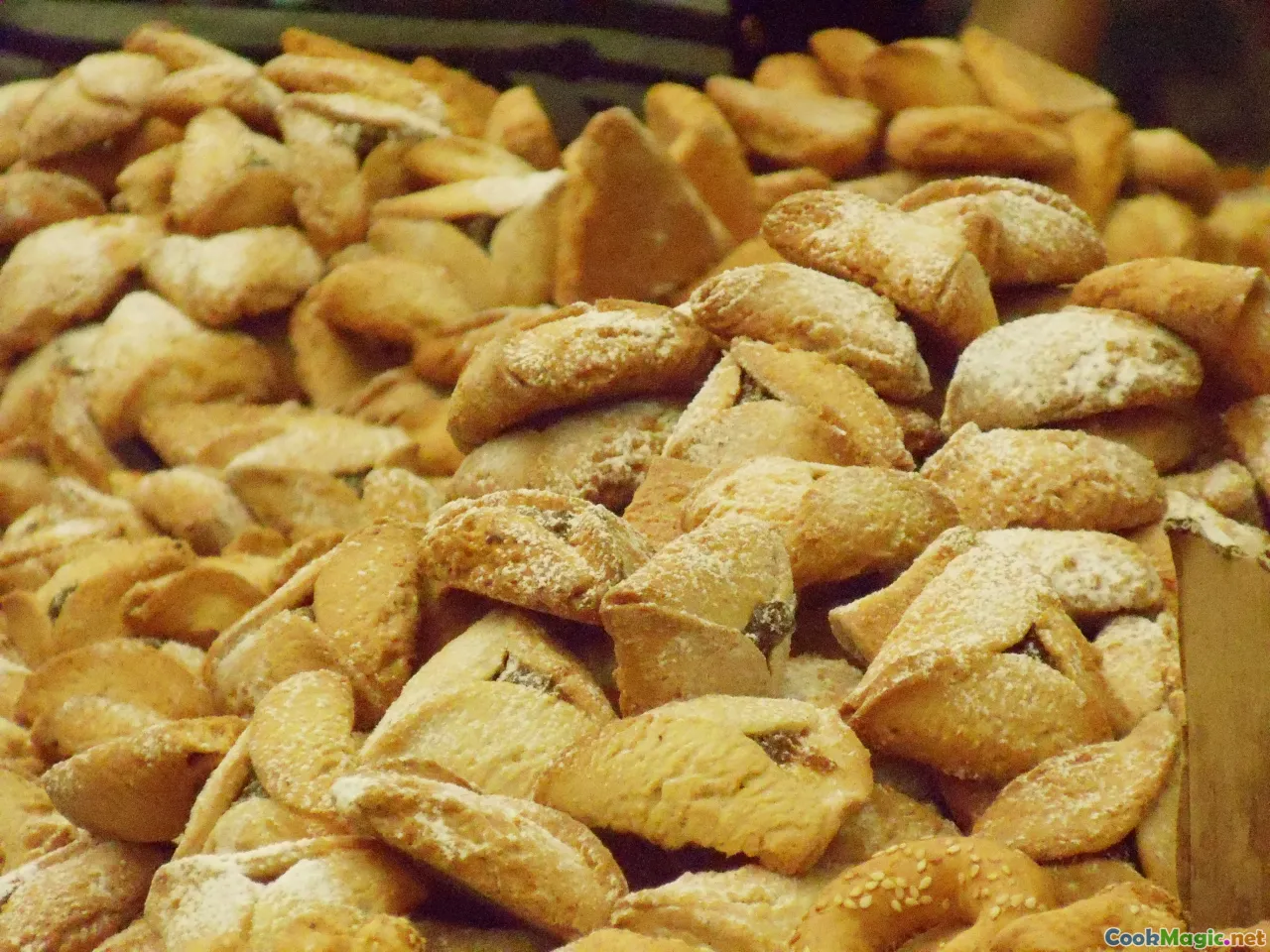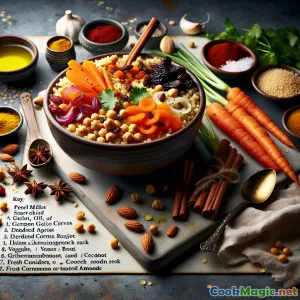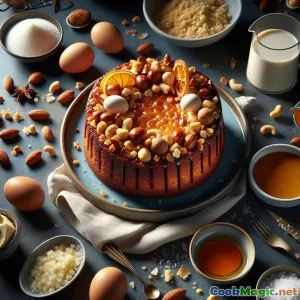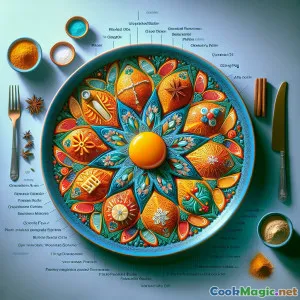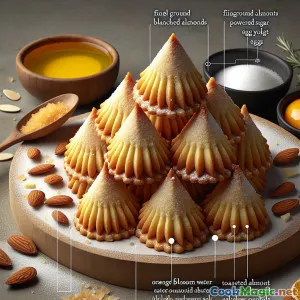
알제리 아몬드 피라미드: 북아프리카의 달콤한 즐거움
(Algiers Almond Pyramids: A North African Sweet Delight)
(0 리뷰)재료
-
250 grams 껍질 벗긴 아몬드 가는 가루
(Freshly ground yields best flavor)
-
120 grams 가루 설탕
(Sifted for smoothness)
-
1 large 계란
(실온)
-
1 large 계란 노른자
-
37 grams 무염 버터
(부드럽게 된)
-
1 tbsp 오렌지 블로섬 워터
(Essential for classic aroma)
-
1/8 tsp 소금
-
few drops 식용 색소 (주황색 또는 분홍색)
(Optional for decoration)
-
18 pieces 토스트 아몬드 반쪽
(토핑용)
체 친 가루 설탕, as needed
(Freshly ground yields best flavor)
(Sifted for smoothness)
(실온)
(부드럽게 된)
(Essential for classic aroma)
(Optional for decoration)
(토핑용)
영양 정보
- 인분: 18
- 1인분 크기: 2-3 cookies (about 60g)
- Calories: 550 kcal
- Carbohydrates: 49 g
- Protein: 15 g
- Fat: 36 g
- Fiber: 6 g
- Sugar: 31 g
- Sodium: 62 mg
- Cholesterol: 61 mg
- Calcium: 134 mg
- Iron: 2.4 mg
조리법
-
1 - Mix Almond Cookie Dough:
In a bowl, thoroughly mix ground almonds, powdered sugar, and salt. Add the softened butter and work until crumbly.
-
2 - Add Wet Ingredients:
Beat the egg and egg yolk lightly with orange blossom water. Gradually pour into the almond mixture, blending until you get a soft, pliable dough.
-
3 - Color & Divide Dough:
Divide dough and tint one half very lightly with food coloring for aesthetic contrast, if using. This adds a festive note.
-
4 - Shape into Pyramids:
Portion dough into walnut-sized balls (approx. 18). Shape each ball into a small pyramid using lightly damp hands.
-
5 - Add Almond Decoration:
Press a toasted almond half gently onto the top point of each pyramid.
-
6 - Bake:
Place pyramids on a baking parchment-lined tray. Bake in a 165°C (330°F) preheated oven for 15–17 minutes, until just golden at edges. Do not overbake.
-
7 - Finish with Sugar:
Cool slightly, then generously dredge cookies in powdered sugar for a delicate coat before serving.
In a bowl, thoroughly mix ground almonds, powdered sugar, and salt. Add the softened butter and work until crumbly.
Beat the egg and egg yolk lightly with orange blossom water. Gradually pour into the almond mixture, blending until you get a soft, pliable dough.
Divide dough and tint one half very lightly with food coloring for aesthetic contrast, if using. This adds a festive note.
Portion dough into walnut-sized balls (approx. 18). Shape each ball into a small pyramid using lightly damp hands.
Press a toasted almond half gently onto the top point of each pyramid.
Place pyramids on a baking parchment-lined tray. Bake in a 165°C (330°F) preheated oven for 15–17 minutes, until just golden at edges. Do not overbake.
Cool slightly, then generously dredge cookies in powdered sugar for a delicate coat before serving.
알제리 아몬드 피라미드: 북아프리카의 달콤한 즐거움 :에 대한 자세한 정보
Algiers Almond Pyramid Cookies: An Edible Tribute to Memory and Tradition
Algiers Almond Pyramid Cookies blend the heart of North African flavor, texture, and symbolism into an enchanting and truly unique treat. These cakes, or as they're known locally, "montegros," carry with them traces of Algeria's landscape and a brief journey across the Maghreb's beloved home bakeries. These cookies, often encountered on festive plates during Eid or at welcoming teas, are much loved—and their pyramid shape is as much about beauty as practicality.
Almonds, aptly called the 'king of nuts' in these regions, are deeply valued in Algerian and broader North African tradition. Their use in sweets is a legacy stretching from the rich gardens of Andalusia through the sunlit markets of North Africa. The ground almond in these cookies creates an irresistibly moist crumb, while subtle notes of orange blossom water recall fragrant city gardens and the bustling energy of Algiers’ historic Casbah.
Workmanship and Unique Aspects
What sets Algiers Almond Pyramid Cookies apart from ordinary thumbprint or plain butter cookies is both shape and nuance. The playful triangular, pyramid-like form pays homage not just to the ancient cultures of North Africa but presents elegance in home dessert plating. These cookies are often lightly tinted in pastel colors—soft orange or radiant pink—reflecting both the sunrise over Algiers’ port and the exuberance of celebration.
The traditional recipe avoids flour, which distinguishes these cookies and lends a chewy, gluten-free structure (always check specialized needs). Many family recipes will vary slightly: some may use rose instead of orange blossom, or decorate more intricately. Here, the delight is understated—a toasted almond sits atop each cookie almost like a finial crowning the sweet edifice.
Experience and Practical Tips
Taking on Algiers Almond Pyramid Cookies is an approachable yet satisfying baking project for special occasions, tea times, or when a taste of the exotic beckons. Precision in measuring the almonds and sugar ensures structure and prevents the mixture from spreading on the tray. Shape the pyramids with slightly moist fingers, as the dough is sticky. You can prepare the almond mixture a day ahead, and even freeze unbaked pyramids for later, making this recipe celebration-ready at any time.'
Bake just until the bases take on slight color—the greatest culinary tragedy here is overbaked cookies, as their delicate interior should reminiscence marzipan rather than conventional biscuits. Powdered sugar dust not only looks lovely but gently tempers the floral fragrance.
Serve these with intensely steeped mint green tea as is customary in North Africa, or as part of an extravagant assortment for a dessert table. Their nutty sweetness, heady aroma and crisp/soggy contrast are positively mesmerizing for curious palates.
Cultural Significance and History
Across Algeria, pastry arts have always been colored by migration, trade and ingenuity. The almond is symbolic—associated with hospitality and prosperity, offered in sweets or left in stoneware dishes for guests. During Islamic feasts or weddings, dainty sweets such as Almond Pyramid Cookies take center stage with baklava, makroud, or semolina cakes, embodying much more than their sum of parts.
Visually, these cookies capture a quintessentially Algerian blend of refinement and rootedness—the gold dust hue of nuts paired with the festive spire. Creating and sharing these sweets is an act both personal and communal; very often, stories and tips are passed from mother to daughter, assurance that intent is part of the pleasure.
Modern Adaptations & Final Thoughts
Contemporary cooks occasionally substitute ground pistachios or even hazelnuts for fresh takes, and experiments with flavor extract have been successful. But orange blossom water is essentially unmatched; if unavailable, rose water works, yet transports the cookies Eastward in narrative.
Algiers Almond Pyramid Cookies are perfect for those wanting to retrace footsteps of culinary explorers or add an elegant, unforgettable cookie to their repertoire. Remember: they are as beautiful to behold as they are to taste, bound to awaken storytelling or memory long after the last crumb has vanished.

